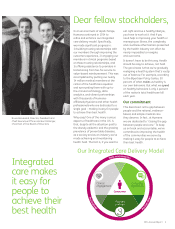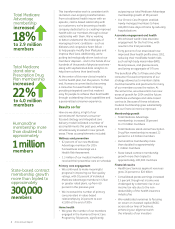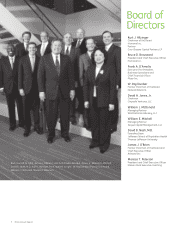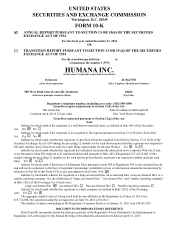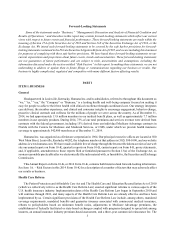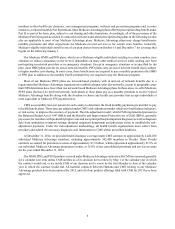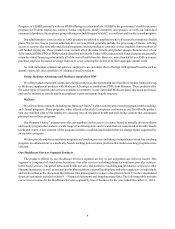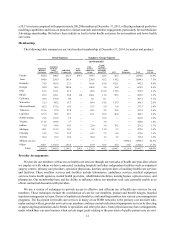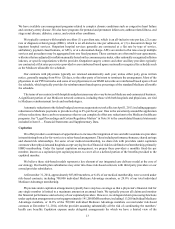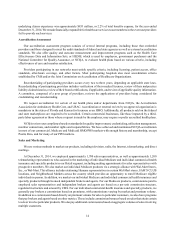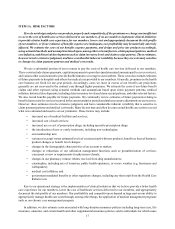Humana 2014 Annual Report Download - page 15
Download and view the complete annual report
Please find page 15 of the 2014 Humana annual report below. You can navigate through the pages in the report by either clicking on the pages listed below, or by using the keyword search tool below to find specific information within the annual report.7
Individual Medicare Stand-Alone Prescription Drug Products
We offer stand-alone prescription drug plans, or PDPs, under Medicare Part D, including a PDP plan co-branded
with Wal-Mart Stores, Inc., or the Humana-Walmart plan. Generally, Medicare-eligible individuals enroll in one of our
plan choices between October 15 and December 7 for coverage that begins on the following January 1. Our stand-alone
PDP offerings consist of plans offering basic coverage with benefits mandated by Congress, as well as plans providing
enhanced coverage with varying degrees of out-of-pocket costs for premiums, deductibles, and co-insurance. Our
revenues from CMS and the beneficiary are determined from our PDP bids submitted annually to CMS. These revenues
also reflect the health status of the beneficiary and risk sharing provisions as more fully described in Item 7. –
Management’s Discussion and Analysis of Financial Condition and Results of Operations under the section titled
“Medicare Part D Provisions.” Our stand-alone PDP contracts with CMS are renewed generally for a calendar year
term unless CMS notifies us of its decision not to renew by May 1 of the calendar year in which the contract would
end, or we notify CMS of our decision not to renew by the first Monday in June of the calendar year in which the
contract would end. All material contracts between Humana and CMS relating to our Medicare stand-alone PDP products
have been renewed for 2015, and all of our product offerings filed with CMS for 2015 have been approved.
We have administered CMS’s Limited Income Newly Eligible Transition, or LI-NET, prescription drug plan
program since 2010. This program allows individuals who receive Medicare’s low-income subsidy to also receive
immediate prescription drug coverage at the point of sale if they are not already enrolled in a Medicare Part D plan.
CMS temporarily enrolls newly identified individuals with both Medicare and Medicaid into the LI-NET prescription
drug plan program, and subsequently transitions each member into a Medicare Part D plan that may or may not be a
Humana Medicare plan.
Medicare and Medicaid Dual Eligible and Long-Term Care Support Services
Medicare beneficiaries who also qualify for Medicaid due to low income or special needs are known as dual eligible
beneficiaries, or dual eligibles. The dual eligible population represents a disproportionate share of Medicaid and
Medicare costs. There were approximately 9.6 million dual eligible individuals in the United States in 2014, trending
upward due to Medicaid eligibility expansions and individuals aging into the Medicare program. These dual eligibles
may enroll in a privately-offered Medicare Advantage product, but may also receive assistance from Medicaid for
Medicaid benefits, such as nursing home care and/or assistance with Medicare premiums and cost sharing. The dual
eligible population is a strategic area of focus for us and we are leveraging the capabilities of our integrated care delivery
model, including care management programs particularly as they relate to chronic conditions, to expand our services
to this population. As of December 31, 2014, we served approximately 404,000 dual eligible members in our Medicare
Advantage plans and approximately 992,000 dual eligible members in our stand-alone prescription drug plans.
Since the enactment of the Health Care Reform Law, states are pursuing stand-alone dual eligible CMS
demonstration programs in which Medicare, Medicaid, and Long-Term Care Support Services (LTSS) benefits are
more tightly integrated. Eligibility for participation in these stand-alone dual eligible demonstration programs may
require state-based contractual relationships in existing Medicaid programs. We were successful in our bids for state-
based contracts in Florida and Virginia in 2013 and in Ohio, Illinois, and Kentucky in 2012. Ohio, Illinois, and Virginia
are contracts for stand-alone dual eligible demonstration programs serving individuals dually eligible for both the
federal Medicare program and the state-based Medicaid program. We began serving members in Illinois in the first
quarter of 2014 and in Virginia in the second quarter of 2014. We partner with organizations, including CareSource
Management Group Company, to serve individuals in certain states. We began serving members in Kentucky and certain
LTSS regions in Florida at various effective dates ranging from the second half of 2013 through the first quarter of
2014.
LTSS eligible beneficiaries heavily overlap with the dual eligible population. On September 6, 2013, we acquired
American Eldercare Inc., or American Eldercare, the largest provider of nursing home diversion services in the state
of Florida, serving frail and elderly individuals in home and community-based settings. American Eldercare
complements our core capabilities and strength in serving seniors and disabled individuals with a unique focus on
individualized and integrated care, and has contracts to provide Medicaid long-term support services across the entire
state of Florida. The enrollment effective dates for the various regions ranged from August 2013 to March 2014.


